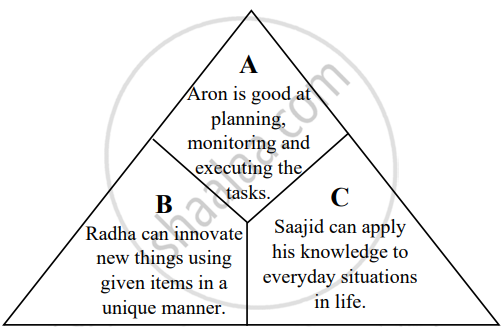Advertisements
Advertisements
प्रश्न

- By referring to Sternberg’s theory, identify the components of intelligence displayed by A, B, and C in the figure given above. (3)
- Elaborate on any two characteristics each of A and C. (4)
उत्तर
- A-Analytical or Componential
B-Experiential or Creative
C-Practical or Contextual - Characteristics:
- A: Analytical or Componential Intelligence:
- Ability to analyse information, recognise patterns, and solve problems systematically.
- Efficient processes like memory, attention, perception, and logical reasoning.
- Ability to identify patterns, draw inferences, and make deductive or inductive conclusions based on available information.
- Ability to make sound decisions and solve problems methodically
- C: Contextual or Practical Intelligence:
- Ability to draw on past experiences to navigate current situations successfully, as displayed by Saajid.
- Ability to use tactic knowledge gained through personal experience rather than formal education. Saajid is able to draw on his own experiences to inform his decision-making and problem-solving processes.
- Street smartness and a clear understanding of social dynamics and interpersonal relationships.
- A: Analytical or Componential Intelligence:
APPEARS IN
संबंधित प्रश्न
In Jensen’s model, Level II represents ______.
____________ refers to the abilities involved in forming, using, and transforming mental images.
If a person has the skill of understanding the motives, feelings, and behaviours of other people, he/she is said to have:
Jasleen is high on critical thinking and can manipulate symbols to solve numerical problems. She is also high on the ability to understand one’s own feelings, motives, and desires. Which of the following intelligence is displayed by Jasleen?
- Spatial
- Logical-mathematical
- Interpersonal
- Intrapersonal
Describe the PASS model of intelligence.
Read the case and answer the question that follows.
|
Alfred Binet, in 1905, was requested by the French government to devise a method by which students who experienced difficulty in school could be identified. Binet and his colleague, Theodore Simon, began developing questions that focused on areas not explicitly taught in schools those days, such as memory, and attention skills related to problem-solving. Using these questions, Binet determined which were ones that served as the best predictors of school success. Binet quickly realized that some children were able to answer more advanced questions than older children were generally able to answer and vice versa. Based on this observation, Binet suggested the concept of mental age, or a measure of intelligence based on the average abilities of children of a certain age group. This first intelligence test is referred to as the Binet-Simon Scale. He insisted that intelligence is influenced by many factors, it changes over time, and it can only be compared in children with similar backgrounds. |
Identify the approach on which the Binet-Simon Intelligence Scale is based. Discuss its features.
Ryan and Shireen are siblings brought up in the same environment. Ryan knows all the formulae in mathematics and can recall them as they are but cannot solve problems based on those formulae, whereas Shireen can use formulae to solve any kind of problem that are based on them. Explain the intelligence they both exhibit. Which approach is this theory based on?
How did Charles Spearman explain the concept of intelligence?
Shamin is a spiritual leader who possesses a particular type of intelligence as explained by Howard Gardner. Identify the intelligence and give reasons for your answer.
Read the case study and answer the question that follows:
| When Srikanth Bolla was born, neighbours in the village suggested that his parents smother him. It was better than the pain they would have to go through their lifetime, some said. He is a “useless” baby without eyes; being born blind is a sin, others added. Twenty-three years later, Srikanth is standing tall living by his conviction that if the “world looks at me and says, Srikanth, you can do nothing, I look back at the world and say, I can do anything.” Srikanth is the Founder and CEO of Hyderabad-based Bollant Industries, an organisation that employs uneducated and challenged employees to manufacture eco-friendly, disposable consumer packaging solutions, which is worth ₹ 50 crore. He considers himself the luckiest man alive, not because he is now a millionaire but because his uneducated parents, who earned ₹ 20,000 a year, did not heed any of the ‘advice’ they received and raised him with love and affection. “They are the richest people I know,” says Srikanth. |
"Srikanth is standing tall living by his conviction that if the "world looks at me and says, 'S.rikanth, you can do nothing', I look back at the world and say, I can do anything." According to Gardner's multiple theory of intelligences, which kind of intelligence explains this? Discuss this intelligence in brief.
